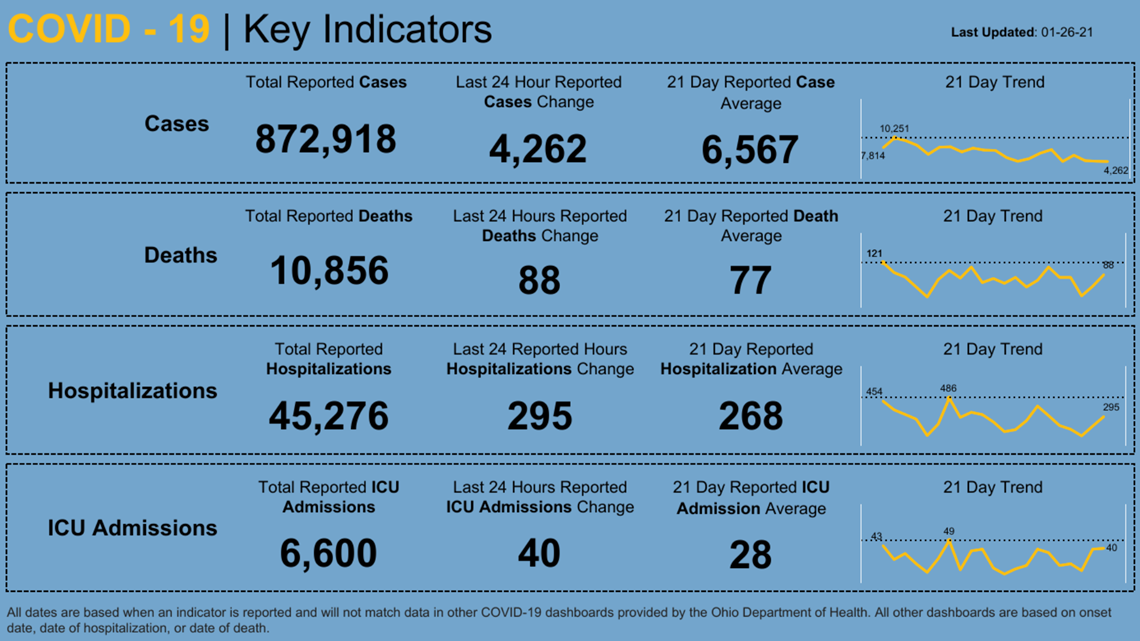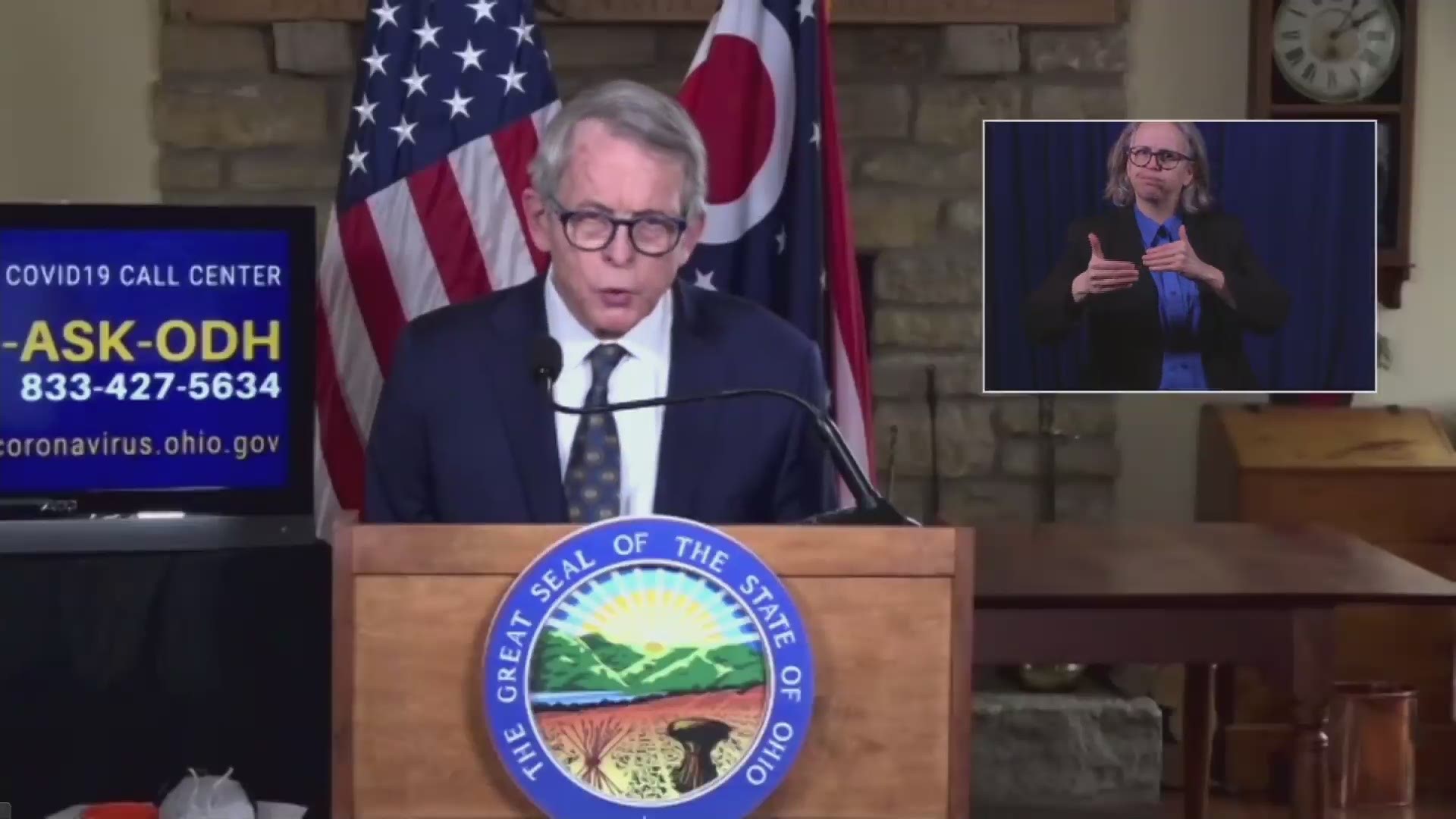COLUMBUS, Ohio — Gov. Mike DeWine addressed Ohioans Thursday afternoon, providing key updates on the state's COVID-19 vaccination effort.
Thursday's update had a major focus on schools, as on Monday, staff join the list of those who qualify for the vaccine.
Here's a breakdown of what was discussed.
SCHOOLS
On Thursday, DeWine reported that out of all the K-12 students in the state, 46% are no back to learning in person, 36% are learning under a hybrid model and just above 17% are still fully remote.
One of the goals for the state's vaccine distribution has been to get kids back in school by March 1. To do this, the state has required each district to sign a letter of intent, promising to return to some form of in-person learning by that date.
So far, DeWine said, every public school in the state has agreed to go back to class in person by March 1 – except for one.
Starting Feb. 1, K-12 school employees qualify for the vaccine, including teachers, bus drivers, cafeteria workers, custodians and anyone else who works within a school building.
While those workers will qualify Monday, not all will be able to actually get the vaccine on that day - or even that week.
Schools with access to vaccines next week have already been notified. However, on Friday, DeWine is expected to notify all other schools, providing information on which week they will receive their doses.
DeWine said on Tuesday the goal is to have every school worker vaccinated, who wants to be, by the end of Feb.
The plan, which will be announced Friday, was created with several important factors in mind:
- Keeping it simple for staff; most K-12 staff in a county will be vaccinated within a seven-day period. The goal is to maximize the capacity of local vaccination partners.
- There is currently a limited supply of the vaccine. The state has pulled leftover vaccine doses from what was previously allocated for nursing homes, specifically for vaccinating our K-12 staff.
- Logistics; DeWine said the plan that will be announced will ensure counties can vaccinate the maximum number of people in the shortest amount of time.
- Local educational service centers are working with local health departments and retail pharmacies to facilitate vaccinations that are convenient for school staff.
DeWine said his team hopes to have about 100,000 vaccines available for the older populations each week, with 55,000 available for schools.
Local educational service centers will work with health departments and other partners to distribute the doses to schools. DeWine said in some cases, vaccines will be brought to a specific school, in other cases, there may be a designated spot for school staff to go.
Regardless, the idea is to separate older Ohioans who are getting the vaccine from school staff, so the two populations aren't competing for doses or appointments.
YOUTH MENTAL HEALTH
In communities across the state, youth are presenting with more acute mental health symptoms during the pandemic in comparison to years past," Ohio Department of Mental Health and Addiction Services Director Lori Criss said Thursday.
"School is community for kids. It benefits them beyond their academic content; it's the social and emotional connections that kids feel with friends, classmates, extracurriculars, teachers and more," Criss said.
Criss explained that remote learning is taking its toll on some students.
The Centers for Disease Control and Prevention (CDC) has recognized that beyond getting sick, many young people's social, emotional and mental well-being has been impacted by the coronavirus pandemic.
Criss said that when kids aren’t in school, the change of routine and constant uncertainty often produces anxiety. Disconnection from learning, emotional, and social supports can lead to depression. Missed significant life events – like proms and sports competitions - can also result in grief.
Criss said you should reach out for help if a young person is:
- Talking about feeling hopeless
- Worrying about being a burden
- Feeling like there's no reason to live
- Using drugs or alcohol or engaging in other risky behaviors
- Struggling with school
- Disconnecting from family and friends
VACCINATION SCHEDULE
- Jan. 19 - Ohioans 80 and older
- Jan. 25 - Ohioans 75 and older; those with severe congenital, developmental and early-onset medical disorders
- Feb. 1 - Ohioans 70 and older; employees of K-12 schools that wish to remain or return to in-person or hybrid learning
- Feb. 8 - Ohioans 65 and older

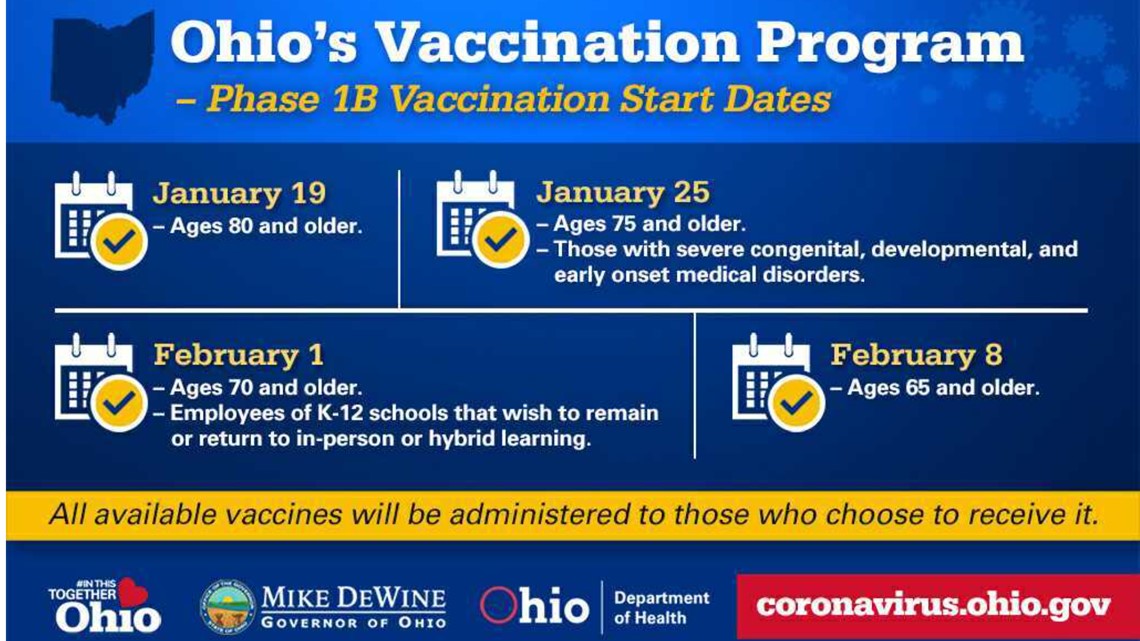
STATEWIDE CURFEW
Starting Thursday night, the statewide coronavirus curfew will move to a start time of 11 p.m. for a period of at least two weeks.
The move comes after the state saw seven straight days with COVID-19 hospitalizations below 3,500.
Earlier this week, the governor announced new criteria his team would be using as they discuss how to move forward:
- If Ohio has seven straight days of hospitalizations below 3,500, the state will go to an 11 p.m. curfew for at least two weeks.
- If hospitalizations drop below 3,000 for seven consecutive days, the state will move to a midnight curfew for at least two weeks.
- If hospitalizations drop below 2,500 for seven consecutive days, state leaders will drop the curfew.
As of Thursday, coronavirus-related hospitalizations were at 2,829.
DeWine said he would reevaluate the data in two weeks, after which the state could move to a midnight curfew, or no curfew.
KEY INDICATORS
On Thursday, the Ohio Department of Health reported:
- 5,432 new cases of COVID-19, compared to the 21-day average of 6,221
- 75 new coronavirus-related deaths, compared to the 21-day average of 74
- 256 new hospitalizations, compared to the 21-day average of 253
- 23 new ICU admissions, compared to the 21-day average of 26

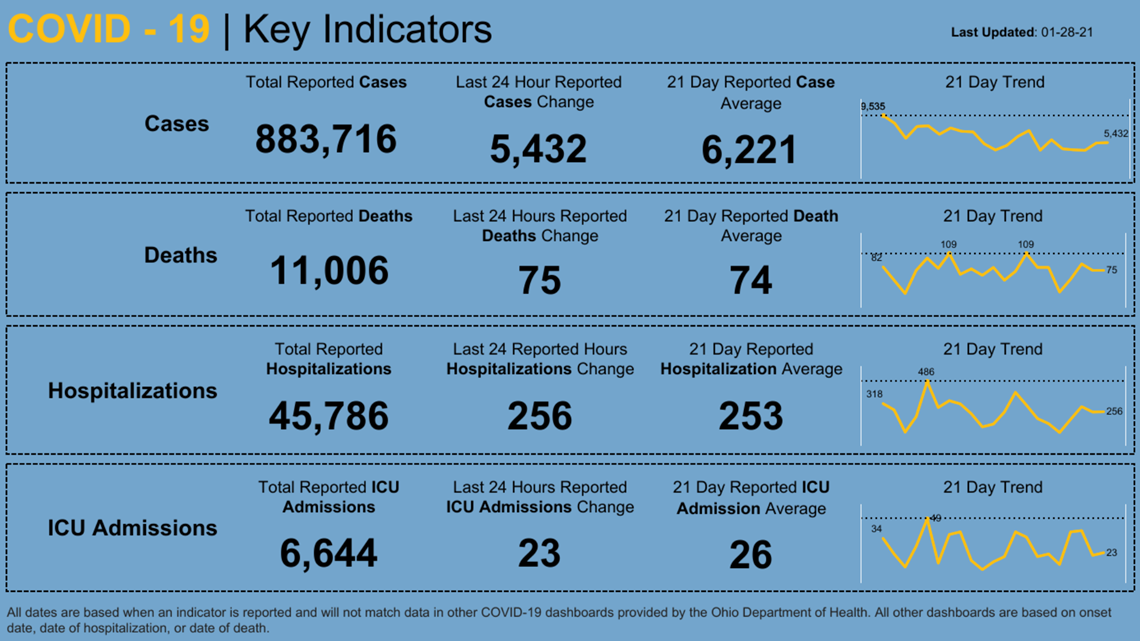
PUBLIC HEALTH ADVISORY MAP
DeWine updated the weekly coronavirus Public Health Advisory map Thursday. One highlight is the fact Hamilton County dropped from Level 4 (Purple).
The rest of the state, however, remained the same.

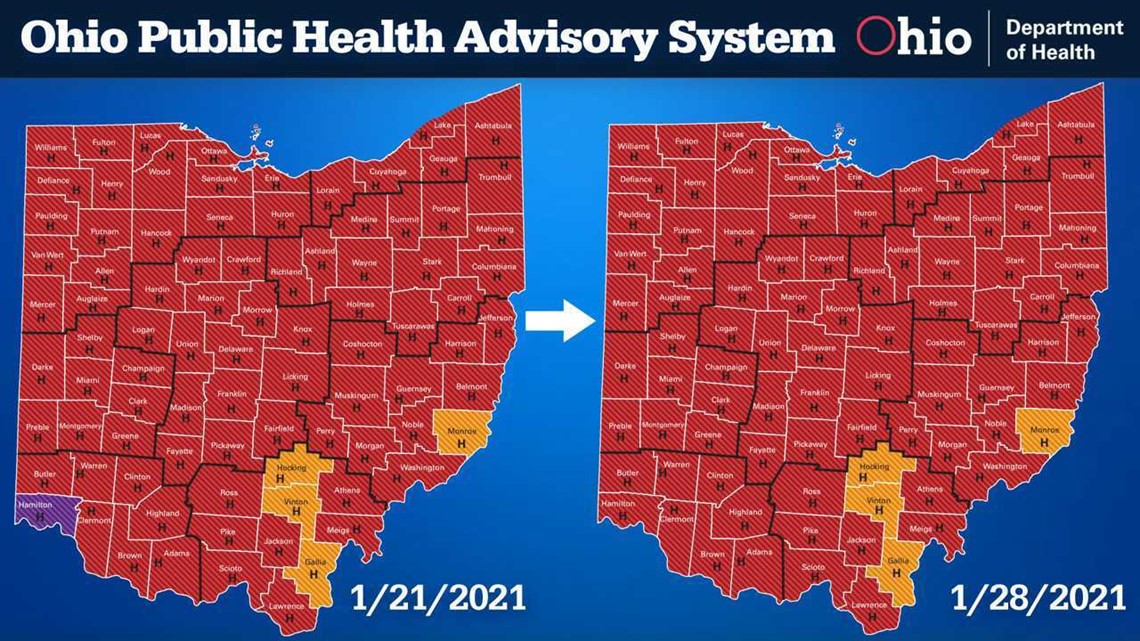
FULL PRESS CONFERENCE
TUESDAY
STATEWIDE CURFEW
DeWine unveiled Tuesday the criteria his team will be using when determining the future of the state's coronavirus curfew.
The curfew currently lasts from 10 p.m. - 6 a.m. each night, however, should the number of COVID-19 patients in Ohio hospitals continue to go down, the start time could get pushed back to 11 p.m., a move that could come as soon as Thursday.
Here's the plan:
- If Ohio has seven straight days of hospitalizations below 3,500, the state will go to an 11 p.m. curfew for at least two weeks. So far, there have been six straight days below this number.
- If hospitalizations drop below 3,000 for seven consecutive days, the state will move to a midnight curfew for at least two weeks.
- If hospitalizations drop below 2,500 for seven consecutive days, state leaders will drop the curfew.
Should these data points go back up, however, the curfew will likely be reinstituted.
Ohio Department of Health Chief Medical Officer Dr. Bruce Vanderhoff said hospitalizations are a lagging indicator, meaning state leaders would need to act quickly.
VACCINE
Ohio has been receiving an average of about 146,000 first doses every week. As Ohio begins finishing up Phase 1A, more doses will be available for those in Phase 1B.
For a two-week period, the state will also have access to additional doses.
Ohio is not drawing down all the vaccine doses that the federal government required the state to set aside for nursing homes, as a number of staff members have declined the vaccine.
Although the state was not supposed to have access to those leftover doses until March, DeWine gained approval to tap into that reserve now. The move gives Ohio another 77,000 doses over the next two weeks to distribute.
ACCESS FOR SENIORS
In an effort to provide better access to scarce vaccine doses for Ohio's oldest and most at-risk citizens, starting Feb. 8, state health officials will begin taking the vaccines directly into affordable senior housing locations. This type of senior housing is home to several thousand Ohioans.
"The threat of serious illness and death from COVID-19 is high in affordable senior housing settings due to the age of residents, the ease of spread in clustered housing complexes, the isolation of many residents who may not have access to information about how to get the vaccine," DeWine said.
Statewide efforts are underway to get these residents vaccinated and health leaders are working with local partners to offer assistance through onsite clinics. These clinics are aimed at easing the burden for many seniors having trouble with the registration process and arranging transportation.
In advance of the clinic day, the state will provide a resource guide with materials to educate residents about the vaccine, advertise the clinic day, and sign individuals up for appointments.
CONGREGATE CARE FACILITIES
There are 953 nursing homes within the state of Ohio. DeWine said Tuesday the state is second in the nation in terms of people vaccinated within those facilities.
Outside of the state's nursing homes, DeWine said the vaccination process for assisted living facilities is well underway.
DeWine released the following data on vaccine compliance:
- State-run developmental centers: 89% of residents have accepted the vaccine.
- State-run psychiatric hospitals: 73% of long-term patients have accepted the vaccine.
- State-run veterans homes: 92% of veterans have accepted the vaccine.
- Those with developmental disabilities but not in state-run facilities: 5,500 people have been vaccinated so far.
SCHOOLS
While the original start date for school staff vaccination was set for Feb. 1, Ohio will actually begin school staff vaccinations this week.
In fact, the state's first school district on the list, located in Cincinnati, will start its rollout in just a few days.
While most other districts will begin next week, there are not enough vaccines to get all schools started Feb. 1.
DeWine said the goal is for every school in the state to have the opportunity to receive its first shot within the month of February.
Schools that will receive the vaccine next week have already been contacted. All other schools should expect to be contacted by Friday with more information.
KEY INDICATORS
On Tuesday, the Ohio Department of Health reported:
- 4,262 new cases of coronavirus compared to the 21-day average of 6,567
- 88 new coronavirus-related deaths compared to the 21-day average of 77
- 295 new hospitalizations compared to the 21-day average of 268
- 40 new ICU admissions compared to the 21-day average of 28

